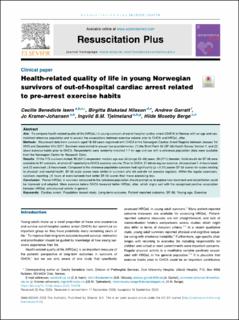| dc.contributor.author | Isern, Cecilie Benedicte | |
| dc.contributor.author | Nilsson, Birgitta Blakstad | |
| dc.contributor.author | Garratt, Andrew | |
| dc.contributor.author | Kramer-Johansen, Jo | |
| dc.contributor.author | Tjelmeland Myrhaugen, Ingvild Beathe | |
| dc.contributor.author | Berge, Hilde Moseby | |
| dc.date.accessioned | 2024-01-16T07:56:32Z | |
| dc.date.available | 2024-01-16T07:56:32Z | |
| dc.date.created | 2023-10-05T15:13:08Z | |
| dc.date.issued | 2023 | |
| dc.identifier.citation | Resuscitation Plus. 2023, 16 . | en_US |
| dc.identifier.issn | 2666-5204 | |
| dc.identifier.uri | https://hdl.handle.net/11250/3111645 | |
| dc.description.abstract | Aim: To compare health-related quality of life (HRQoL) in young survivors of out-of-hospital cardiac arrest (OHCA) in Norway with an age and sex-
matched reference population and to assess the associations between exercise volume prior to OHCA and HRQoL after.
Methods: We present data from survivors aged 18–50 years registered with OHCA in the Norwegian Cardiac Arrest Registry between January 1st
2015 and December 31st 2017. Survivors were invited to answer two questionnaires; (1) the Short Form 36 (SF-36) Health Survey Version 1, and (2)
about exercise habits prior to OHCA. Respondents were randomly matched 1:1 for age and sex with a reference population (data were available
from the Norwegian Centre for Research Data).
Results: Of the 175 survivors invited, 95 (54%) responded, median age was 44 (range 35–48) years, 26 (27%) females. Valid results for SF-36 were
available for 91 survivors, of whom 87 reported pre-OHCA exercise-volume. Prior to OHCA, 21 did no regular exercise, 44 exercised 1–4 hours/week
and 22 exercised 5 hours/week. Compared to the reference population survivors had significantly (p < 0.01) poorer SF-36 scores for scales relating
to physical- and mental health. SF-36 scale scores were similar in survivors who did and did not exercise regularly. Within the regular exercisers,
survivors reporting 5 hours of exercise/week had better SF-36 scores than those exercising less.
Conclusion: Poorer HRQoL in survivors compared to the reference population should prompt us to explore how treatment and rehabilitation could
be improved and adapted. More exercise before OHCA favoured better HRQoL after, which aligns well with the recognised positive association
between HRQoL and physical activity in general. | en_US |
| dc.language.iso | eng | en_US |
| dc.rights | Navngivelse 4.0 Internasjonal | * |
| dc.rights.uri | http://creativecommons.org/licenses/by/4.0/deed.no | * |
| dc.title | Health-related quality of life in young Norwegian survivors of out-of-hospital cardiac arrest related to pre-arrest exercise habits | en_US |
| dc.type | Peer reviewed | en_US |
| dc.type | Journal article | en_US |
| dc.description.version | publishedVersion | en_US |
| cristin.ispublished | true | |
| cristin.fulltext | original | |
| cristin.qualitycode | 1 | |
| dc.identifier.doi | 10.1016/j.resplu.2023.100478 | |
| dc.identifier.cristin | 2182187 | |
| dc.source.journal | Resuscitation Plus | en_US |
| dc.source.volume | 16 | en_US |
| dc.source.pagenumber | 10 | en_US |

